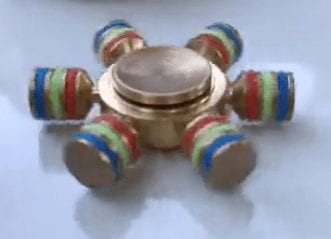If you’ve got yourself a child (or five) between the ages of 6 and 17, I’d venture to guess that you’re no stranger to the fidget spinner fad. The newest “must-have” toy is a triangular-shaped device that spins from the center between two of the user’s fingers.
 YouTube
YouTube
Originally designed to help aid the lack of focus in kids with ADHD, the widely popular toy has now been banned from classrooms across America as a result of its distractibility.
 YouTube
YouTube
Lead poisoning prevention advocate and mother of four, Tamara Rubin isn’t so much concerned with the distraction of fidget spinners as much as she is with the toy’s potential health hazard.
The “MisLEAD” mama’s life was radically changed in 2005 when her children suffered lead-poisoning.
“My son has permanent brain damage. His visual memory is in the fourth percentile. He’s impaired in his ability to make real world choices because of his visual memory and his ability to fully perceive visual input.”
She now dedicates her time to testing popular products for lead and informing others of its silent dangers and whereabouts.
Using an x-ray fluorescent spectrometer, Tamara decided to test a multitude of fidget spinners for their lead safety.
Her findings showed certain spinners to be lead-free, but those composed of brass or containing LED lights proved different. The US Consumer Products Safety Commission states that toys should not contain more than 100 parts per million (ppm) of lead in accessible parts.
 YouTube
YouTube
One of Tamara’s tests found one spinner’s paint coating to contain 334 ppm of lead, and 155 ppm of mercury. A different one of her tests showed brass spinners to contain as much as 42,800 ppm of lead.
How is that possible you ask? Well, there’s no patent on the original fidget spinner, making the product “fair game” for anyone to make, sell and distribute. This means it can be more difficult to trace back lead-based products to any one company because at such a high demand, the spinners have been rapidly produced by a wide variety of “manufacturers,” and sold all over the Internet, in gas stations and almost any random store you could think of.
Lead poisoning isn’t always easy to recognize or diagnose, and often goes overlooked or misdiagnosed. According to the Centers for Disease Control (CDC), when exposed, a person may experience:
- Loss of appetite
- ADHD
- Heart disease
- High blood pressure
- Permanent brain damage
Its effects can also be fatal, especially in infants and young children.
Tamara wants mothers and parents to know that lead poisoning is not a “low income problem,” or a specific to one demographic of people. “It’s an everyone problem.”
As a mother of children who have suffered the effects of lead poisoning, Tamara advises parents to be able to identify the harmful chemicals in lead-contaminated fidget spinners.
“Look for metal that is yellow because the leaded brass is going to be very yellow. And look for the ones that are heavier because the lead is going to make them heavier. Not in all cases, but in some. And then look for ones that have electronic components.”
Unless they’re purchased from an accredited company with proven safety standards, fad toys of any kind often pose a threat to our kids because they are mass-produced at an accelerated rate, with no accountable regulations, making them probable for containing lead.
 Tamara Rubin
Tamara Rubin
Just like we have no way of knowing who is producing each of the various fidget spinners out there, Tamara is unable to test every fidget spinner on the market. Because of this, she cannot make recommendations of a specific spinner that is fun and safe for children, but advises parents to err on the side of caution.
I found yet another fidget spinner with super high lead! This is the highest lead one yet!
http://www.TamaraRubin.com
http://www.GoFundMe.com/LeadSafeMama
#XRFTesting
#FidgetSpinners
#LeadedFidgetsPosted by MisLEAD: America’s Secret Epidemic on Monday, May 29, 2017
